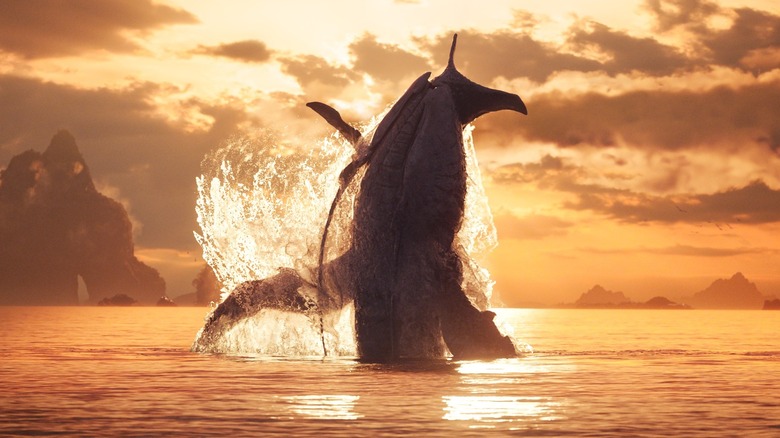How Much Did Avatar: The Way Of Water Really Cost & Why Was It So Expensive?
It's no secret that James Cameron's "Avatar: The Way of Water" cost a boatload (no pun intended) of cash to bring to the big screen. When you watch it, every shot practically oozes money, from the complex visual effects that bring the characters to life to the sweeping CGI vistas of Pandora. Add in an extremely long production window and one of the bigger marketing pushes in recent memory (though it was no "Barbie"), and you've got a movie that needed a ginormous box office take just to break even.
It's hard to say concretely just how much "Avatar: The Way of Water" really cost, but enough information has come out since the film's release to give us a pretty good idea. According to The Hollywood Reporter, sources claimed that the film's production budget exceeded $400 million, and that even a conservative estimate for marketing would put the total over $600 million. However, the actual cost was surely much higher. Per THR, Cameron himself claimed during press for the film that it would need to make around $2 billion to be successful. Other sources told the outlet that "The Way of Water" needed $1.4 billion just to break even — an absurd figure for pretty much any other director or franchise.
Fortunately for all involved, "Avatar 2" grossed $2.32 billion worldwide, making it a financial win and the third highest-grossing movie ever. But what exactly made "The Way of Water" so ridiculously expensive?
What made Avatar: The Way of Water so expensive?
Most sci-fi blockbusters in the vein of "Avatar: The Way of Water" cost a pretty penny to produce, but James Cameron's aquatic epic had a few unique features that made it particularly pricey. One of the biggest was the underwater filming itself, which required the development of all-new camera technology in collaboration with special effects house Wētā FX.
Shooting live actors underwater for full 3D while also doing complete performance capture of their faces and bodies — that was the mission for "Avatar 2," and one that demanded groundbreaking tech. Cameron and his extensive team were ultimately able to get results, creating the striking imagery and fluid subaquatic shots featured in the final film. However, the process for doing this kind of multilayered production and effects work was a lot more complicated than simply shooting in front of a green screen.
Since the first "Avatar," Cameron's intention has been to deliver a sci-fi movie experience unlike what else is on the market. That requires more complex methods of filming, which in turn requires a bigger budget. It also didn't help that "The Way of Water" was delayed numerous times, leading to a production period that lasted far longer than most movies would ever even approach. The project started filming in August 2017, and it wasn't released in theaters until more than five years later.
Will James Cameron's other Avatar sequels be as expensive as Avatar 2?
Despite the massive success of its predecessor, "Avatar: The Way of Water" was a big gamble. It had a gargantuan budget, and the long gap between the first and second films made it less of a surefire hit. However, it managed to achieve almost the same level of box-office success. That means that Disney might be just as inclined to open the budgetary floodgates for Cameron's upcoming "Avatar" sequels, but will "Avatar 3," "Avatar 4," and "Avatar 5" need the same amount of money?
Making movies isn't getting any cheaper. That being said, there's reason to believe that "Avatar 3" might actually be less expensive than "The Way of Water." For one, Cameron shot an unknown but apparently significant amount of the next film during production on "Avatar 2," as it made sense to shoot future scenes while all the actors and tech were assembled. That's one of the big benefits of planning out multiple movies at a time, and given how pricey the production methods of "Avatar" are, it could save some big bucks on the next installment.
Additionally, future "Avatar" movies might have less expensive settings than "The Way of Water." Cameron has been a big fan of subaquatic filmmaking for decades, so that element will surely remain in some form, but we don't know to what extent. The director has teased a fire twist in "Avatar 3," but it could still be a less pricey vision than the seaside world of "Avatar: The Way of Water."


